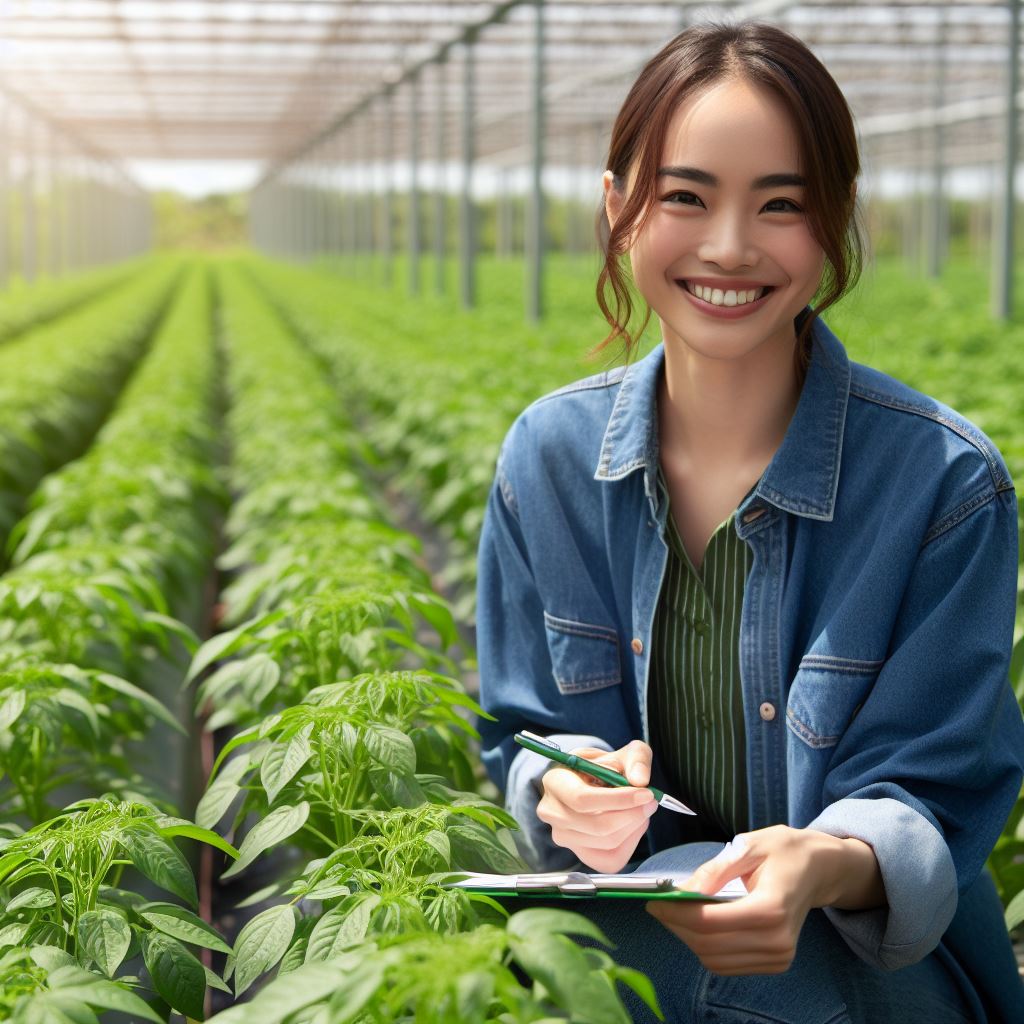Green Tech in Farms: Cost Analysis
Last Updated on February 3, 2024
Introduction
In recent years, the concept of Green Tech in Farms has gained significant attention.
This term refers to the adoption of environmentally friendly technologies in agricultural practices.
Green Tech not only aims to improve the productivity and efficiency of farms but also focuses on reducing the environmental impact of agriculture.
Cost Analysis plays a crucial role in the implementation of Green Tech on farms.
It involves assessing the financial feasibility of adopting specific technologies or practices.
By analyzing the costs involved, farmers can make informed decisions about implementing Green Tech solutions on their farms.
Understanding the importance of cost analysis is vital for farmers who want to adopt sustainable practices without incurring excessive expenses.
By conducting thorough cost analysis, farmers can identify costs associated with purchasing equipment, installation, maintenance, and operation of Green Tech solutions.
Moreover, cost analysis enables farmers to evaluate the return on investment and calculate the payback period for implementing Green Tech.
This analysis takes into account various factors such as energy savings, reduction in chemical inputs, and increased productivity.
In fact, Green Tech in Farms encompasses the adoption of environmentally friendly technologies in agricultural practices.
Cost analysis plays a crucial role in assessing the financial feasibility of implementing these technologies.
It allows farmers to make informed decisions and optimize the implementation of Green Tech on their farms, balancing environmental sustainability with economic considerations.
Read: Tech-Enhanced Agri Supply Chains
Benefits of Green Tech in Farms
Green tech in farms brings a wide range of benefits across environmental, economic, and social aspects.
Environmental benefits
On the environmental front, it significantly reduces the carbon footprint of farming activities.
Through sustainable practices like organic farming and crop rotation, it promotes a healthier ecosystem.
Additionally, green tech ensures efficient use of water resources through sophisticated irrigation systems and rainwater harvesting techniques.
Economic benefits
The economic benefits of green tech in farms are substantial.
By reducing the reliance on chemical fertilizers and pesticides, farmers can decrease their operating costs significantly.
Furthermore, implementing advanced technologies and precision agriculture techniques increases crop yields and productivity, leading to higher profits.
The emergence of the green tech sector also creates new job opportunities, contributing to economic growth.
Social benefits
In terms of social benefits, green tech in farms positively impacts public health by reducing exposure to harmful chemicals commonly used in conventional farming.
It promotes the production of nutritious and safer food, thus benefiting consumers.
By supporting sustainable farming practices and rural development, it strengthens local communities.
Moreover, it enhances overall food security through the establishment of resilient and sustainable food production systems.
In short, the benefits of green tech in farms are vast and far-reaching.
From the environmental perspective, it helps reduce greenhouse gas emissions, conserve water, and preserve soil quality.
Economically, it lowers operating costs, increases productivity, and creates employment opportunities.
Socially, it improves public health, produces safer food, supports local communities, and ensures food security.
Embracing green tech in farms is not only an environmentally responsible choice but also a smart economic and social investment.
Read: Agricultural Drones: Transforming Farming
Factors to Consider in Cost Analysis
Implementing green technology in farms involves analyzing various factors to determine the overall cost effectiveness.
By carefully considering these factors, farmers can make informed decisions about whether or not to adopt green tech solutions.
Initial investment
One of the primary factors to consider in cost analysis is the initial investment required for implementing green tech in farms.
This includes the purchase and installation costs of various green technologies such as solar panels, wind turbines, or efficient irrigation systems.
Farmers need to evaluate the upfront expenses and assess whether the long-term benefits outweigh the initial costs.
Operating costs
Along with the initial investment, analyzing the ongoing operating costs associated with green technology is critical.
This includes expenses such as electricity required to run solar panels or wind turbines, water usage for efficient irrigation systems, and any additional costs for maintaining and monitoring the technology.
Farmers need to compare these costs with traditional farming methods to determine the economic viability of green tech in the long run.
Maintenance expenses
Another factor to consider in cost analysis is the maintenance expenses involved in utilizing green technology in farms.
Regular maintenance is necessary to ensure the optimal functioning of the green tech systems.
This may include servicing solar panels or wind turbines, inspecting and repairing irrigation systems, and performing routine checks to identify any potential issues.
Farmers need to budget for these maintenance expenses to keep their green tech solutions operating efficiently.
Potential savings
While analyzing the costs of implementing green tech in farms, it’s crucial to consider the potential savings that can be achieved.
Green technology can help reduce energy consumption, decrease water usage, and improve overall efficiency, leading to cost savings in the long term.
For example, solar panels can generate electricity, reducing the reliance on the traditional power grid and lowering energy costs.
Efficient irrigation systems can minimize water wastage, resulting in reduced water bills.
Farmers need to evaluate these potential savings to determine the financial benefits of adopting green tech solutions.
In essence, cost analysis plays a vital role in the decision-making process when it comes to implementing green tech in farms.
By evaluating factors such as initial investment, operating costs, maintenance expenses, and potential savings, farmers can make informed choices and determine the overall cost effectiveness of incorporating green technology.
It’s essential to carefully assess these factors to ensure a sustainable and economically viable transition towards greener farming practices.
Read: Vertical Farming: Urban Agri-Tech Trend

Cost Analysis of Specific Green Technologies
Green technologies in farms, such as solar panels, wind turbines, and energy-efficient equipment, offer opportunities for cost savings and sustainability.
Analyzing the cost aspects of these specific technologies can help farmers make informed decisions about adopting them.
Solar panels
Solar panels are a popular green technology in farms due to their ability to harness the sun’s energy.
The initial investment for solar panels can be expensive, including the cost of purchasing and installing the panels.
However, the operating costs for solar panels are relatively low, as they require minimal maintenance and no fuel expenses.
The potential savings from using solar panels can offset the initial investment over time.
Wind turbines
Wind turbines are another green technology option for farms.
They rely on wind energy to generate electricity.
The initial investment for wind turbines can be significant, considering the cost of purchasing and setting up the turbines.
Operating costs for wind turbines include routine maintenance and occasional repairs.
However, by harnessing wind power, farms can potentially save on electricity bills and even sell excess energy back to the grid, resulting in long-term returns on investment.
Energy-efficient equipment
Investing in energy-efficient equipment is also a viable option for farms aiming to reduce their environmental footprint.
While the initial investment for energy-efficient equipment may be higher compared to traditional equipment, the operating costs are significantly lower.
This is because energy-efficient equipment consumes less energy, resulting in reduced utility expenses.
Over time, there can be potential savings in energy consumption, leading to reduced operational expenses for the farm.
It is important for farmers to evaluate their specific farm size, energy requirements, and budget constraints while considering green technologies.
Conducting a cost analysis of these technologies provides valuable insights into the financial feasibility of implementing them on the farm.
Factors such as available sunlight, wind conditions, and energy usage patterns should be taken into account to accurately assess the potential savings.
In review, embracing green technologies in farming can lead to significant cost savings and promote sustainability.
Solar panels, wind turbines, and energy-efficient equipment offer various cost benefits in terms of initial investments, operating costs, and potential savings.
By carefully evaluating the cost aspects of these technologies, farmers can make informed decisions to optimize their farm’s energy efficiency and reduce their environmental impact.
Read: Greenhouse Automation: Agri-Tech Evolution
Case Studies on Cost Analysis in Farms
EcoDairy Farms: Implementing solar panels
- EcoDairy Farms conducted a thorough cost breakdown before implementing solar panels on their farm.
- The cost breakdown included the purchase and installation of solar panels, wiring, and other equipment.
- EcoDairy Farms found that the initial cost was high but the long-term savings made it a worthwhile investment.
- They calculated the return on investment by considering the energy savings and any excess energy sold back to the grid.
- Overall, EcoDairy Farms experienced a positive return on their investment within a reasonable timeframe.
Stahlbush Island Farms: Incorporating wind turbines
- Stahlbush Island Farms decided to incorporate wind turbines to harness renewable energy.
- They analyzed the cost of purchasing and installing wind turbines, including any necessary infrastructure.
- The cost breakdown also factored in maintenance and repair expenses over the projected lifespan of the turbines.
- Through careful analysis, Stahlbush Island Farms determined that the return on investment was favorable.
- By reducing their reliance on traditional energy sources, they were able to save significantly on operational costs.
Straus Family Creamery: Upgrading to energy-efficient equipment
- Straus Family Creamery recognized the importance of upgrading to energy-efficient equipment.
- They conducted a cost breakdown to determine the expenses associated with replacing old machinery.
- The analysis revealed that the upfront cost of purchasing energy-efficient equipment was higher.
- However, the return on investment was evident in the form of reduced energy consumption and lower utility bills.
- Straus Family Creamery was able to recoup their investment in a relatively short period and experienced long-term savings.
These case studies demonstrate the benefits of implementing green technology on farms.
Though the initial costs may be significant, the return on investment and long-term savings are substantial.
EcoDairy Farms successfully integrated solar panels into their operations, resulting in positive returns.
Stahlbush Island Farms found that wind turbines offered both financial and environmental advantages.
Straus Family Creamery upgraded to energy-efficient equipment, ultimately reducing energy consumption and increasing savings.
These examples highlight the viability of green tech in farms and emphasize the importance of conducting a thorough cost analysis before implementing any solutions.
Conclusion
Recap of the importance of cost analysis in Green Tech implementation
In harnessing Green Tech for farms, cost analysis emerges as the linchpin for success.
Transparent financial scrutiny ensures optimal resource allocation.
Encouragement for farms to consider and analyze the costs of implementing Green Tech
Farms must embrace the imperative of dissecting expenses tied to Green Tech adoption.
Prudent financial assessment paves the way for sustainable agricultural practices.
Future prospects of cost-effective Green Tech solutions in farms
Looking ahead, the horizon gleams with promise for farms.
Innovations promise cost-effective Green Tech solutions, ushering in an era of eco-friendly and economically sound agriculture.


